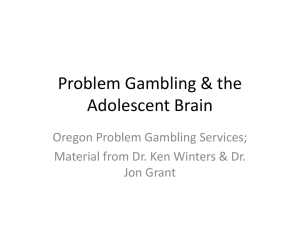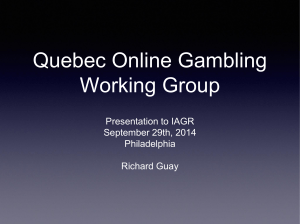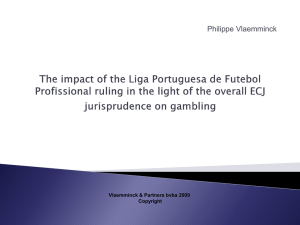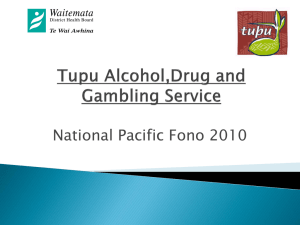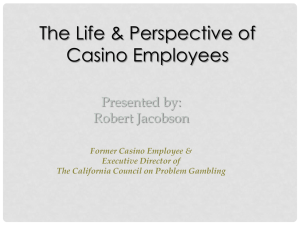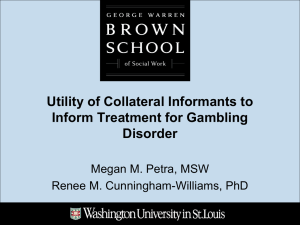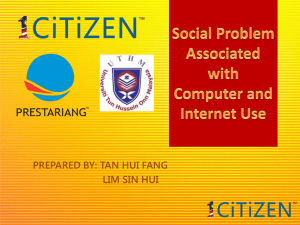Problem gambling - Royal College of Psychiatrists
advertisement
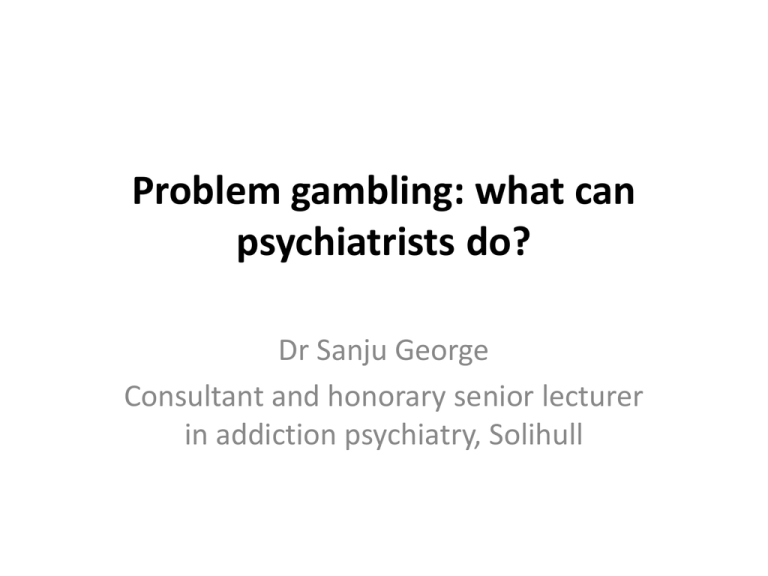
Problem gambling: what can psychiatrists do? Dr Sanju George Consultant and honorary senior lecturer in addiction psychiatry, Solihull Focus of this talk • Why psychiatrists should do more and what they can do to help Britain’s problem gamblers Declaration of interests • I am on the National Responsible Gambling Strategy Board (advises the Government on education, research and treatment aspects of gambling) – views expressed here are my own and not the Board’s • I (my NHS Trust) was awarded a grant by the Responsible Gambling Fund (now the Responsible Gambling Trust) to study the gaps in identification of gambling problems by mental health professionals. Definition of gambling • Gambling is betting something of value (usually money) on an event (usually a game) whose outcome is unpredictable or determined by chance. Gambling in Britain • Nearly 70% of Britons had participated in at least one gambling activity in the past 12 months. • Most popular gambling activities were National lottery (57%), scratch cards (20%), betting on horse races (17%) and fruit/slot machines (14%). Gambling in Britain • Gambling, for the large majority is a normal and socially – sanctioned leisure activity • But for a significant minority, gambling can progress from being a recreational activity to being a problem or addiction. • 0.9% of the population are problem gamblers and an additional 7.3% are ‘at risk’ gamblers Definition of problem gambling • Gambling that disrupts or damages personal, family or recreational pursuits The gambling continuum Gambling disorder in DSM V • Will be re-classified in DSM-5 in the category of addictive disorders. • Terminology will change to gambling disorder Why should psychiatrists do more? • 1. Co-morbidity: – Around 50% of problem gamblers also suffer from a co-existing psychiatric disorder - most common conditions are depression, anxiety, substance misuse and personality disorders. – Patients seeking treatment for psychiatric disorders are much more likely than the general population to suffer from gambling problems – e.g. prevalence of gambling problems among treatment-seeking substance misusers is between 5% and 30% Why should psychiatrists do more? • 2. Despite such high rates of comorbidity gambling problems often go undetected and unaddressed, possible reasons: patients’ reluctance to discuss gambling behaviours (due to shame, stigma and guilt); and psychiatrists’ lack of awareness and knowledge of the condition. Why should psychiatrists do more? • 3. Problem gambling if untreated can have wide ranging negative impacts on the individual (physical and psychiatric disorders and financial difficulties), family (interpersonal relationship problems, domestic violence, and negative impact on children) and society (crime and absenteeism at work) Why should psychiatrists do more? • 4. There are easy to use screening tools and brief psychological interventions for problem gambling that can be readily used in mental health settings. • 5. Early intervention can very often result in significantly positive outcomes What can psychiatrists do? • Psychiatrists can and should attempt to screen their patients (at least the high risk ones) for problem gambling, and when patients screen positive, offer brief psychological interventions where possible, and where this is not feasible refer them to specialist services. Screening for problem gambling • There are several gambling screening tools available but there is no one ‘gold standard’ measure. • The Problem Gambling Research and Treatment Centre (2011) evaluated the brevity, sensitivity, validity and reliability of 16 of the better known problem gambling screening tools and came up with a short list of 7 ‘recommended’ tools Screening for problem gambling • Categorized into short, medium and long screening tools • Short: these consist of three or fewer questions. • Medium: 9 questions • Long: 14 to 21 questions A short gambling screening tool: the Lie/Bet questionnaire • Have you ever felt the need to bet more and more money?’ • Have you ever had to lie to people important to you about how much you gamble? • An affirmative response to either question is considered a positive screen and identifies a person with gambling problems The Birmingham Adult Gambling Screen (BAGS) (Orford, J, George, S, and Rusling, L, 2011). • In the past 12 months how often…. 1) Have you bet more than you could really afford to lose? Almost always (3) most of the time (2) some of the time (1) never (0) 2) Have people criticised your betting, or told you that you have a gambling problem, whether or not you thought it is true? Almost always (3) most of the time (2) some of the time (1) never(0) 3) Have you felt guilty about the way you gamble or what happens when you gamble? Almost always (3) most of the time (2) some of the time (1) never (0) Scoring BAGS • The scoring range for the screen is zero to nine. • A score of zero means no problem, a score of one suggests a possible gambling problem, and we suggest offering information to those people who score one on gambling responsibly (could use the RCPsych leaflet on problem gambling) • A score of two or more indicates problem gambling, warranting a brief psychological intervention and/or referral to a specialist service. Brief interventions for problem gambling – what are they? • Brief interventions (BIs), are by definition brief psychological interventions designed for use with people who use addictive substances or engage in behaviours (such as gambling) problematically but who have not yet developed a full-blown addiction. Brief interventions for problem gambling - Rationale • The rationale is that such brief interventions will prevent the progression of the addictive disorder, and they are ideal low - cost, high volume interventions that can be delivered by non-specialists in non-specialist settings. Birmingham Gambling Intervention Tool (B – GIT) • Easy to use BI tool, originally developed by Petry and recently adapted for use in the UK (Rusling L, George S, Orford J, 2011) • Only takes 10 to 15 minutes B – GIT : Step 1 • In step 1 the concept of gambling continuum and the meaning of these terms are explained to the patient. • Then, using a pi chart the person is given a percentage breakdown of how people gamble - i.e. relative breakdown of non-gamblers, recreational gamblers, at risk gamblers and problem gamblers in the general population. Step 1 Step 1 B – GIT : Step 2 Step 2 involves discussing the harms associated with problem gambling: these include financial harms, family harms, health harms and negative impact on work. figure B – GIT : Step 3 • Step 3 consists of discussing simple and practical measures to reduce gambling such as: – limiting the amount of money one spends gambling – reducing the amount of time and days spent gambling – not to view gambling as a way to make money – to spend time instead doing other non-gambling activities. B-GIT – Step 3 Where BIs are not feasible or sufficient • Refer to gambling treatment services. Themes for further discussion • • • • Current treatment provision Future commissioning Specialist vs generic treatment services Ethical aspects of funding treatment services Conclusion • Problem gamblers often go unrecognised and un helped in psychiatric settings • Untreated problem gambling can have significant adverse consequences • Early interventions can improve outcomes • Psychiatrists should do more (screening and brief interventions) to help problem gamblers Useful web links 1. Royal College of Psychiatrists’ information leaflet (www.rcpsych.ac.uk/metal healthinfo/problems/problemgambling.aspx) 2. GamCare (www.gamcare.org.uk) 3. Gamblers Anonymous (www.gamblersanonymous.org.uk)
